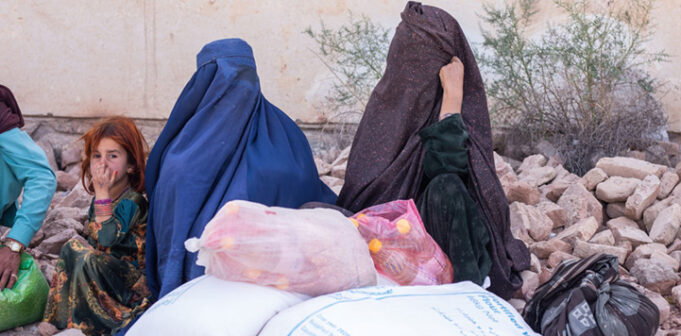KABUL, Afghanistan—The bitter cold of Afghanistan’s winter has small children huddled beneath blankets in makeshift camps. Sick babies in hospitals lie wrapped in their mothers’ all-enveloping burqas. Long lines at food distribution centers have become overwhelming as Afghanistan sinks deeper into desperate times.
Since the chaotic Aug. 15 Taliban takeover of Kabul, an already war-devastated economy once kept alive by international donations alone is now on the verge of collapse. There isn’t enough money for hospitals.
Saliha, who like many Afghans uses just one name, took her infant son to the Indira Gandhi Children’s Hospital in the capital, Kabul. Weak and fragile, four-month-old Najeeb was badly malnourished.
The World Health Organization is warning of millions of children suffering malnutrition, and the United Nations says 97 percent of Afghans will soon be living below the poverty line.
For millions living in camps for the displaced or sitting outside government ministries seeking help, the only source of warmth is to huddle around open wood-burning fires.
Nearly 80 percent of Afghanistan’s previous government’s budget came from the international community. That money, now cut off, financed hospitals, schools, factories and government ministries. In the Taliban’s Afghanistan there is no money. Sanctions have crippled banks while the UN, the United States and others struggle to figure out how to get hundreds of millions of dollars of humanitarian aid to Afghans while bypassing the Taliban, even as there are no immediate signs of the widespread corruption that characterized the previous administration.
For many of Afghanistan’s poorest, bread is their only staple. Women line up outside bakeries in the city, young children arrive before dawn to get bread. The majority scramble to find food, and fuel. The statistics provided by the UN are grim: Almost 24 million people in Afghanistan, around 60 percent of the population, suffer from acute hunger. As many as 8.7 million Afghans are coping with famine.
School for girls under the Taliban is erratic, and in many provinces, they are not allowed to attend school after sixth grade, but in more than 10 provinces schools are open. The international community is working on ways to help the schools that are open while encouraging the Taliban to open the rest.
In some areas, such as the western Herat province, teachers and parents together cajole local Taliban leaders to open schools. In schools like Tajrobawai Girls High School in Herat, it is paying off.
Months ago, the United Nations High Commissioner for Refugees warned of a mass exodus of Afghans should Afghanistan be allowed to free fall into an economic abyss.
The exodus has already begun as thousands stream out of Afghanistan for Iran in desperation. By the hundreds they pack buses that take them from Herat to nearby Nimroz province from where they make the dangerous trek into Iran. Some hope to go further to Turkey and eventually to Europe—despite Europe’s increasing determination to keep migrants out. (AP)













